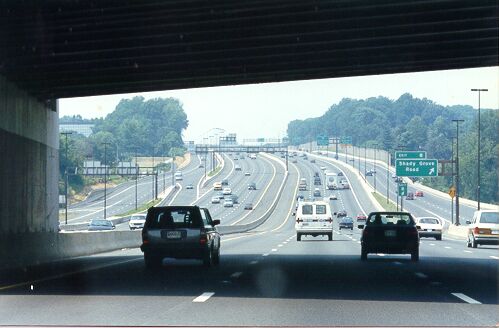| I-270 and I-370 in Maryland |
The Washington National Pike, US-240, was completed from Frederick, Maryland to Connecticut Avenue near Chevy Chase, Md. in the late 1950's, in conjunction with the US-40 bypass of Frederick. These highways were four-lane freeways.
In the early 1960's, US-240 became I-70S, and the Frederick bypass became I-70. I-70 enters Maryland at Hancock, and split into two routes at Frederick, I-70N to Baltimore, and I-70S to Washington. The easternmost two miles of US-240 (through Rock Creek Park) was upgraded and became part of I-495. That explains the winding alignment of I-495 today in that area. With the construction of I-495, the west wye of I-70S was built and designated I-270. The two wyes are in a long-distance sense the same road, as it takes both of them to interchange I-495; the east wye interchanges I-495 east and the west wye interchanges I-495 west/south. In a local sense, since each wye has an interchange with a local thoroughfare, they are separate roads, so the two wyes are kind of an unusual highway feature. There were the I-270 roadside trailblazers on the west wye, but the big overhead signs signed it southbound as "TO I-495 SOUTH" and northbound as "TO I-70S NORTH".
In February 1975, the I-70S/I-70N designations were changed; I-70N was changed to I-70, and I-70S was changed to I-270. The west wye was changed to I-270 Spur. The upgrade of the four-lane US-40 Baltimore National Pike east of Frederick was not completed until 1975; this became six-lane I-70. The 10 miles of I-70N between US-40 and I-695 was completed in the late 1960s. The rest was completed after the route number change.
I-70N never existed in a complete Frederick-to-Baltimore route. The 7-mile-long US-40 four-lane freeway bypass of Frederick was completed in the late 1950s, and in the early 1960s it was designated with portions of I-70 and I-70N, with the easternmost 2 miles being I-70N. The four-lane-divided US-40 Baltimore National Pike was completed between Frederick and Baltimore in the mid-1950s. The 10 miles of I-70N between US-40 near West Friendship, and I-695, was completed in the late 1960s, and extended 2 miles to Security Boulevard at the Baltimore city line about 1970. The lane widths are, four lanes from US-40 to US-29, six lanes from US-29 to I-695, and eight lanes from I-695 to where the Interstate was truncated at the city line. Those were the original lane widths and the highway has not been widened. The rest of the Frederick-Baltimore Interstate highway was completed after the 1975 route number change. The 22-mile upgrade of the four-lane-divided US-40 Baltimore National Pike from Ijamsville Road east of Frederick to the I-70/US-40 junction near West Friendship was completed in 1975; this became six-lane I-70. The timing would indicate that all sections of this 22-mile-long section were under construction by the time that the route number changed in 1973. The last 6 miles of I-70 between the east end of the Frederick Bypass and Ijamsville Road was built on new location with six lanes and was completed in 1986, and the US-40 highway that it bypassed was an at-grade expressway.
Why did Baltimore get the main-line I-70 designation and Washington the spur I-270? Some cities may feel more status with a main-line interstate, but with D.C. being the center of power that it is, most residents probably couldn't care less whether they got I-70 or I-270. And, the decision was probably a Maryland decision rather than a D.C. decision, naturally, Maryland would tend to favor Baltimore. Besides, I-70 is an east-west route, so it probably makes more sense to continue east to Baltimore than southeast to D.C.
In 1972, I-270 was widened to six lanes from the wye split near Tuckerman Lane to MD-118, a distance of 13 miles. In 1989, I-270 was widened to twelve lanes (2-4-4-2 configuration) from the wye split to I-370 (9 miles), and eight lanes from there to MD-118, a total of 13 miles. In 1997, widening to six lanes was completed from MD-118 to MD-121, a distance of 3 miles. In 1997, widening to six lanes was completed on both wyes, with upgraded interchanges with I-495. This completes the expansion of I-270 from I-495 to MD-121. These projects cost over $400 million to construct. Studies are underway to widen I-270 to six lanes from MD-121 to Frederick.

Above, northbound on I-270, 12-lane dual-divided highway near Shady Grove.
I-270 was originally planned to cross the Beltway and enter the District of Columbia and end at a junction with proposed I-95 in north central D.C. The road inside the Beltway would have been called the North Central Freeway. It was cancelled in the 1970s. See Roads to the Future article Washington D.C. Interstates and Freeways.
I-370 is unusual in two respects. One is the fact that it is an interstate spur off another interstate spur (I-270). The second is the fact that it was built as a spur into a rapid rail transit station. The Metrorail Red Line ends at the Shady Grove Station, and I-370 is the direct expressway link from the station to I-270 northwestward for interfacing cars, van pools, and busses. I-370 is 3 miles long, and has four lanes. I-370 was opened around 1990. The proposed Inter-County Connector would extend from I-370 to the Baltimore-Washington Parkway at Laurel, Md., but to my understanding, would not have an interstate design or designation.
One of its main purposes of I-370 was to be a spur into the rapid rail transit station. However, it extends west of I-270 also, as an arterial (non-Interstate) road. The whole corridor serves as a relief route for busy Shady Grove Road. Also, I-370 was developed with the idea that the Inter-County Connector would eventually branch from I-370, about 3/4 mile north of the Metro station, and head east about 18 miles to the Baltimore-Washington Parkway at Laurel.
By Scott M. Kozel, Roads to the Future
(Completed 9-1997, updated 1-20-2002)
